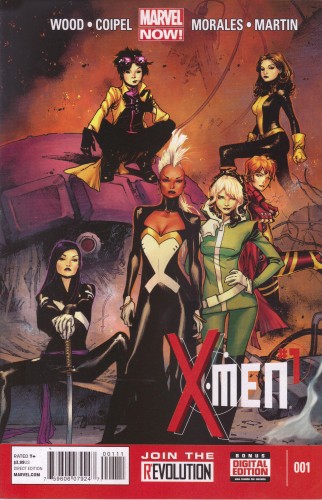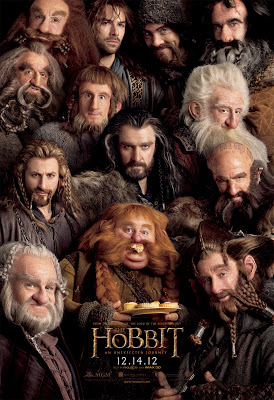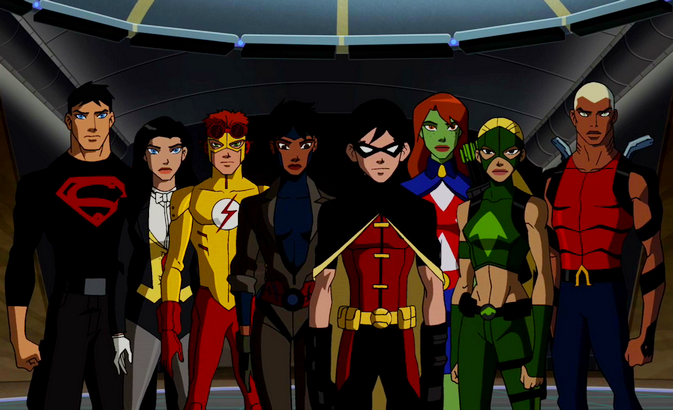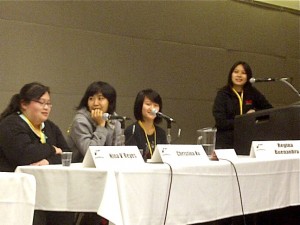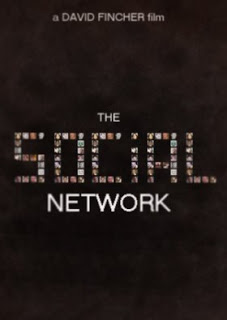This is a guest post by Lisa Pavia-Higel.
Geek culture is big business. The big summer Hollywood blockbusters this year are almost exclusively drawn from comics and other science fiction, or fantasy franchises. From X-Men Days of Future Past to Guardians of the Galaxy, what was once a small audience has become a massive source of revenue for Hollywood. It’s also big business for the comic’s industry. The release of Guardians sparked one of the largest sales months for comics in recorded history. This is great news for the two big players in the world of comic publishing, as they attract new audiences and new readers to their franchises. DC and Marvel have television and film media planned well into the next decade.
This is also very good news for those who care about how women are portrayed in modern media. That may seem counter-intuitive, given that comics have long been criticized for how they depict women, and how women are treated in the industry. However, an influx of new creative talent, an enthusiastic and ever more diverse fanbase, and a host of characters with long, and complex histories have made comics a wellspring of vast potential for new and better stories. The products created based on comic books can, when done right, be far better than the average action/adventure fare and has the potential to bring more and higher quality action-oriented female roles to the big and small screen.
It’s true that the comic genre has issues with women. There are problems within the industry in how female creators and critics are treated, issues with the art styles that often objectify women’s bodies, and serious issues when women venture into spaces where geek culture is present. In a Bitch Media article, Janelle Asselin published her research on sexual harassment in the comics industry. In her survey of more than 3,600 respondents, 59 percent felt that sexual harassment was a problem in the industry and 25 percent had experienced harassment themselves. In the world of convention goers, 13 percent reported comments of a sexual nature and 8 percent reported sexual assaults while attending cons. Asselin notes that with the growing number of women attending conventions and other fan-centered events, those percentages means that more than 10,000 women in attendance at San Diego Comic Con (one of the largest comic conventions of the year) would have experienced harassment of some kind. As a comic fan, writer, and critic, Asselin knows that the industry is hostile from first-hand knowledge. In May of 2014, she criticized a Teen Titans cover on Comic Book Resource (a comic industry website) and received not only hate mail, but also rape threats. It’s clear that there are systemic issues within both the industry and among the fans. So why is Hollywood’s embrace of comic culture a good thing?
First, because the established source material hosts a slew of strong female characters. Art aside, women were superheroes in comics long before they were fighting the good fight in films or on television. The first female superhero appeared in comics in the 1940s, long before Wonder Woman came along to break TV barriers. Mainstays of current hits like the Avengers can trace their hero backstories to the 1960s when Pepper Pots and Black Widow made their debuts. Catwoman, who most recently appeared in The Dark Knight Rises first appeared in comics in 1961. While their level of agency and influence has certainly changed over the years, characters who have been appearing in comics this long have a great deal from which to draw. And their art aside, women in comics are often far stronger and wield far more power than their counterparts in action television and film. Superhero women not only pass the Bechtel test time after time in the pages of comic books, unlike the run of the mill action heroines, they rarely are saved in their own stories.
Take, for example Black Widow and Maria Hill in the aforementioned Avengers. In the film, neither woman is saved by a male character, and both are strong members of their respective teams. Now this could be because the film’s director, Joss Whedon, has long time devotion to both strong female characters and the comic genre. He’s reported that the second Avengers film will host four female lead characters and will feature them as strong members of the team.
So from where do bad superheroine portrayals come? The problems often arise when these characters, who all have extensive and complex backstories, are translated by those who really don’t understand them. For example, in June David Goyer who will be bringing the new Justice League film to life, was asked what he would do with a long running character, She-Hulk, in a film. His answer was that this character was probably created so that geeky men could fantasize about her having sex with the Hulk, and that she was a “green pornstar.” The reaction among fans was immediate. Comic fans and producers responded to the quote calling out Goyer. Even Marvel magnate and geek guru Stan Lee responded to the controversy defending She-Hulk’s background and personal agency. Even though she bears a name derived from a male character, they laud her feminist values and strength as something they love about the series. She would make an excellent female lead, but this producer could not see beyond the way she was drawn. It’s clear that this producer didn’t take the time to really appreciate the legacy that comics offer for their strong female characters.
Moreover many studio producers just don’t think women can carry action films. This idea is being systematically disproven and it seems like even Hollywood producers are beginning to see the potential of tapping these franchises. According to an article in Time Magazine, Sony pictures will be expanding its Spider Man franchise to include a female super hero and Marvel studio president Kevin Feige said that a female-led Marvel film would happen “sooner rather than later.” This could be in response to new data that says in the last year, films with female leads made more money than those without a strong female presence.
There seems to be reason for optimism here. The new art for Wonder Woman’s role in the Batman vs. Superman film shows a short, but reasonably costumed with Gal Gadot’s stance powerful and strong in the middle of the frame. No butt shot, nor over the shoulder look. We can only hope her characterization will be as good as the image seems to indicate. Marvel also announced at San Diego Comic Con that Thor, a key role in the Avengers universe would be taken over by a women (not for the first time) and that the transformation would be a long, non-temporary story arc. While many critics were unhappy with the choice, wondering why they wouldn’t create a new female character, it presents even more interesting opportunities within the hero context.
While there is cause for excitement among female fans about seeing old favorites finally make it to big screen, many are more excited to see some of the work being produced by some of the newer talent in the industry. Beyond the world of the Avengers, Batman and Superman, there is an exciting cast of characters ripe for film or television adaptation. A new renaissance is happening within comics that is producing a greater variety of characters and characterizations. From Kelly Sue DeConnick and Dexter Soy’s Captain Marvel who has inspired an entire fandom called the Carol Corps, to Brian K. Vaughan and Fiona Staples’ Saga series which was, until the release of Rocket Raccoon #1, the best-selling comic on the market, a greater diversity of writers and artists are making new characters that Hollywood could, and should draw from.
These titles are bringing new fans and a greater female audience, and they are active, excited, and involved in their media. The aforementioned Carol Corps that formed around the new Captain Marvel specializes in body positive, family friendly cosplay, and produces Carol wear for those fighting cancer. Another online campaign, I am Comics was created in response to Janelle A.’s experience over the Teen Titans debacle, and the ConSent campaign was created at the San Diego Comic Con to help those engaging in cosplay to feel safer in that context by raising awareness that cosplay (dressing up as a character) does not give anyone permission to engage in harassment.
The efforts to make comics a more welcoming place is also coming from the industry. In the aftermath of Asselin’s harassment, the hosting website, Comic Book Resource responded by resetting their forums and publishing a new policy on harassment and online conduct.
No genre is perfect, and comic books and graphic novels certainly have their problems. However, as art primarily created for the male gaze slowly changes, and as a greater diversity of writers and artists break into the world of comics, there is a great potential for dynamic and exciting storytelling that does what all art should: challenge, excite, and entertain us. The cast of film-worthy women continues to grow, and as they wait in the wings all we can do is continue to demand that their stories be told, and when they are, to vote with our dollars sending a message to Hollywood that their time has come.
Recommended Reading
If you are interested in trying out some comics with great female characters:
Fearless Defenders–A short-lived series about an all-female team.
Captain Marvel—In Pursuit of Flight: The first trade paperback in the series.
Lumberjanes–This series has been compared with Buffy the Vampire Slayer.
Saga–the number one best-selling series which tells the story of an interspecies war and a child born of two sides. NSFW!
Recommended Viewing
The Talking Comics Vlog on the Geek and Sundry Channel features great titles to get you started.
See Also
The Women of Captain America–The Winter Soldier
Black Widow is More than Just a Pretty Face
The Avengers: Strong Female Characters Failing the Bechdel Test
Lisa Pavia-Higel is a community college educator living in St. Louis, Missouri. When she is not raising her 3-year-old geeklet she writes, performs with an all-female stage combat troupe, and is currently teaching herself to sew, badly. She has also mastered the art of playing video games while yelling at the screen about the stereotypes present within them, which gives her feminist husband and gaming partner no end of joy. Follow her on Twitter @lisamariepavia
